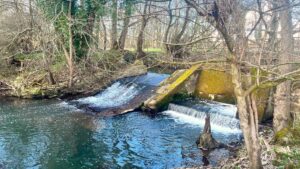A project to restore the natural habitat of the River Ecclesbourne and support the recovery of Atlantic salmon has begun.

Working with partners at the Wild Trout Trust, Chatsworth Estate, and Nestlé Waters, Derbyshire Wildlife Trust is managing a new project to improve water quality, enrich the ecological status of the river and re-meander a section of the river back to its original channel. This will bypass a weir at the site of the former Postern Mill in Turnditch and create a route for fish migration.
A tributary of the River Derwent, the Ecclesbourne rises near Wirksworth and flows southeast for approximately 18km to join the Derwent near Duffield. The ecological status of the river is classed as “Moderate” against the Water Framework Directive by the Environment Agency, due to pollution and physical barriers preventing fish movement throughout the watercourse.
A Wild Trout Trust habitat assessmenti reports that the river has a large amount of potential spawning habitats for Atlantic salmon, a priority conservation species, and other fish species found in the Derwent Catchment, but their movement is prevented by the presence of manmade structures.
The new project will bypass the weir and restore the river to its original course before it was diverted for milling in the 18th century, opening over 28km of river and tributaries for fish, and improving the ecological status of the river.
The excavation and construction of the new channel, due to start in the Autumn, will reinstate fish passage for many species, including salmonii, classified as ‘vulnerable’ in Europe, and eeliii classified as ‘critically endangered’ globally by the International Union for Conservation of Nature. Other species to benefit include grayling, trout, lamprey, minnow, stone loach, and bullhead.
Jennifer Kril, Living Rivers Officer at Derbyshire Wildlife Trust, said: “We are incredibly excited to be starting this project to improve the Ecclesbourne River’s natural habitats, provide passage for a whole host of fish species, and improve its overall health. It also offers great opportunities for local schools and communities to get involved, learn more about their water environment and make a positive difference to wildlife.
“Getting this project to the start line has been a huge team effort and we are delighted to be working with our partners to protect this watercourse as part of our mission for nature’s recovery.”
Tim Jacklin, Deputy Director of the Wild Trout Trust, added: “This is a great example of the type of project required to save our threatened migratory fish. We are delighted to be working with our partners on this project which builds on the removal of Snake Lane weir, Duffield, in 2022. Completion of the project at Postern Mill will open up the whole River Ecclesbourne, allowing salmon once again to return from the North Atlantic all the way to Wirksworth – and back again!”
Hayley Lloyd House, Head of Corporate Affairs and Sustainability at Nestlé Waters UK, said: “We are looking for ways to play an active role in supporting the regeneration of local water cycles, this includes the Derwent Catchment, within which our Derbyshire site operates. It’s where we bottle at source BUXTON natural mineral water and Nestlé Pure Life spring water, and where we protect water resources through nature-based solutions.
“This World Water Day, we are proud to be announcing this collaborative project which will provide significantly more water for vulnerable fish species to re-colonise in the Ecclesbourne River. Locally, we anticipate the impact will be long lasting, enhancing the health of the river, its biodiversity, and provide benefits for the local community. It’s one example of more than 100 projects Nestlé Waters are implementing around the world to help create a positive water impact where we operate.”
Whilst work to restore the river is carried out, Derbyshire Wildlife Trust is engaging with local schools and communities about the ways in which they can contribute to the regeneration of rivers.
Work to control invasive Himalayan Balsam in the catchment will also be carried out along 6km of riverbank. Introduced here in 1839, it is now an invasive weed of riverbanks and ditches, where it prevents native species from growing and contributes to increased bank erosion during Winter months.
Pictured credited to Jennifer Kril, Living Rivers Officer at Derbyshire Wildlife Trust.
i https://www.wildtrout.org/assets/reports/Ecclesbourne_2019.pdf


